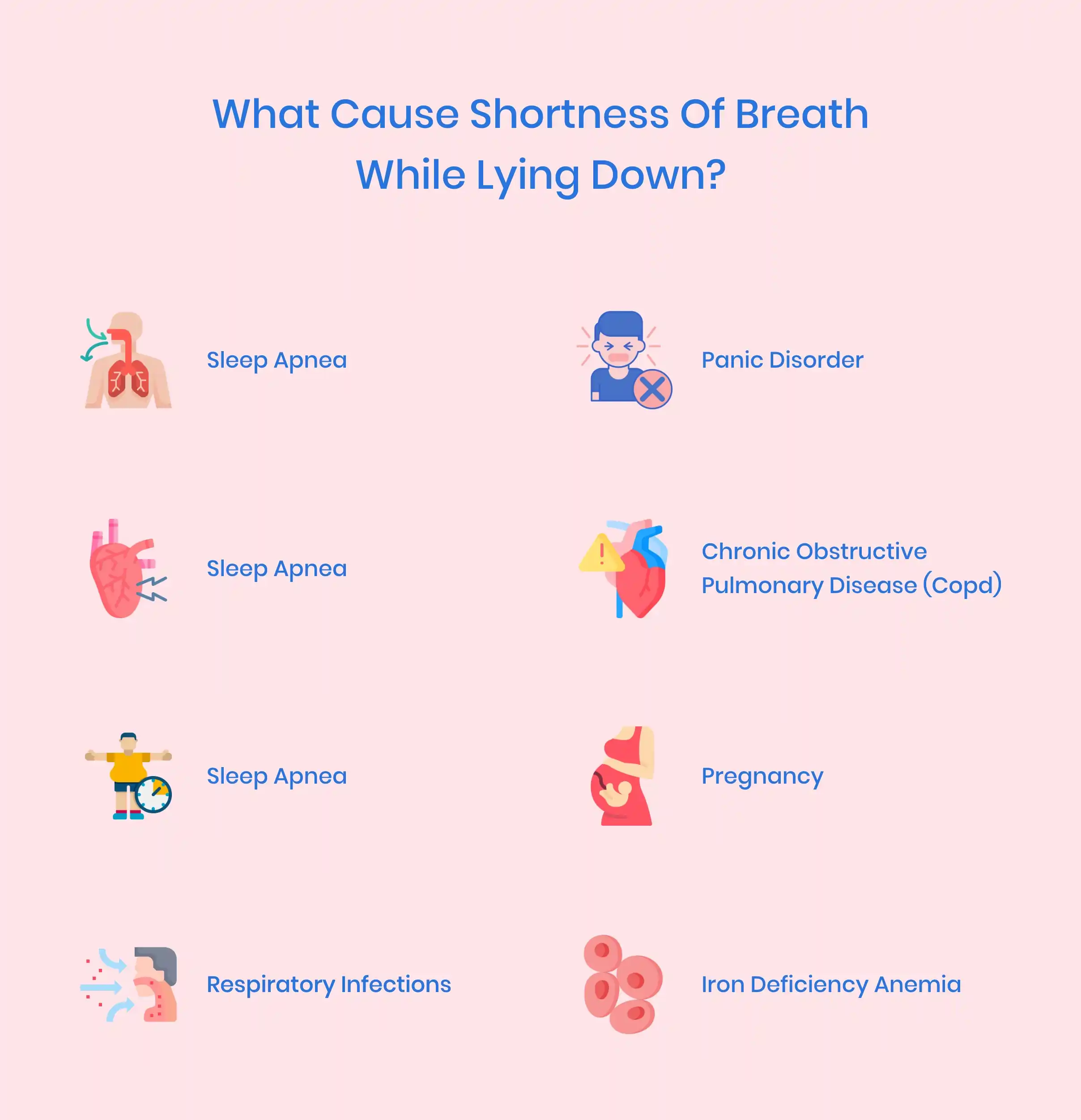Sleep Health
Published July 27, 2022
10 minShortness of Breath When Lying Down: Causes & Cure
Shortness of breath after physical activity or solid health issues like stress and anxiety is normal. But experiencing shortness of breath when lying down and no other reason may indicate a serious me

Table of contents
Sleep Apnea ObesityPanic Disorder Chronic Obstructive Pulmonary Disease (COPD) Pregnancy Respiratory Infections Iron deficiency anemia How to sleep to avoid shortness of breath When To See A Doctor Final Thoughts Frequently Asked Questions
Shortness of breath after physical activity or solid health issues like stress and anxiety is normal. But experiencing shortness of breath when lying down and no other reason may indicate a serious medical condition.An orthopnea is a medical term for discomfort when breathing while lying down flat. It happens because of fluids in the lungs. And once stood or sat up, the breathing may normalize again. However, orthopnea is different from other breathing conditions, such as,
- Paroxysmal nocturnal dyspnoea (PND) is the shortness of breath when lying down at night, and the patients are usually awakened after one to two hours of sleep.
- Platypnea is shortness of breath when standing up or sitting. However, platypnea is relieved when lying down on the back.
- Trepopnea is a symptom of heart failure, where the patient feels shortness of breath when lying down sideways.
- Bendopnea is a novel symptom in heart failure patients, feeling breathlessness when bending forward.
Sleep Apnea
Sleep apnea can be one of the reasons for an individual who can't breathe at night when lying down. It is a potential sleep disorder in an individual, characterized by repeated episodes of upper airway closure during sleep, making it hard to breathe when lying down on back. And besides trouble breathing when lying down, sleep apnea includes other symptoms.Symptoms
Common symptoms of sleep apnea include:- Snoring loudly
- Obstructive breathing during sleep
- Can't breathe at night when lying down
- Waking up with a dry mouth or sore throat
- Headaches in the morning
- Difficulty staying asleep
- Excessive daytime sleepiness
- Inattentive while awake
- Irritability
Obesity
It's possible that you'll have trouble breathing normally if you're overweight. Your chest and abdomen may be constrained and unable to stretch when lying down entirely. In addition to specific diseases and drug concerns, obesity can also be brought on by lifestyle choices.Obesity is frequently associated with numerous medical disorders, including diabetes, high blood pressure, hypertension, and several types of cancer. Symptoms can be alleviated by losing weight with a good diet and exercise program, but you should always talk to your doctor about a weight loss plan.Symptoms
Adult obesity symptoms typically include:- Extra body fat, especially at the waist
- Breathing difficulty
- More sweating
- Snoring
- Difficulty sleeping
- Skin issues brought on by moisture buildup in the folds
- Inability to carry out simple physical activities
- Fatigue (can range from mild to severe)
- Mental health conditions include low self-esteem, depression, humiliation, and social exclusion
Panic Disorder
A person with a panic disorder has anxiety or panic episodes, a sense of being out of control, intense fear, and alienation. A person experiencing a panic attack may have shortness of breath or difficulty breathing for several minutes. A person may also experience shivering, sweating, coughing, lightheadedness, and tingling in addition to the psychological symptoms. You should seek counseling, CBT, or psychotherapy if you have a panic disorder.Symptoms
Symptoms of a panic disorder include:- Rapid or pounding heart
- Sweating
- Chills
- Trembling
- Having trouble breathing
- Dizziness or weakness
- Numb or tingly hands
- Chest pain
- Nausea or stomach pain
- Extreme fear and anxiety
- Social isolation
Chronic Obstructive Pulmonary Disease (COPD)
Chronic obstructive pulmonary disease (COPD) is commonly caused by poor air quality. Emphysema and chronic bronchitis are two examples of COPD. It is challenging to breathe properly with COPD because the air sacs in the lungs are destroyed, and the breathing tubes are constricted.If left untreated, COPD deteriorates over time. Although inhalers, surgery, and rehabilitation can help with symptoms, treatment cannot undo lung damage.Symptoms
Below are the signs and symptoms of COPD :- Breathlessness
- Wheezing
- Chest constriction
- A persistent cough that may release clear, white, yellow, or greenish mucus
- Recurrent respiratory infections
- Respiratory infections
- Sudden weight loss
- Swelling (in ankles, feet, or legs)
Pregnancy
Being out of breath while pregnant is natural and usually goes away after delivery. The diaphragm and lungs are particularly vulnerable to pressure from the expanding uterus during pregnancy, which reduces lung capacity. Additionally, the progesterone hormone that the body produces causes the brain to breathe more quickly. The body has to pump more blood as the pregnancy progresses to support the developing fetus.Symptoms
Pregnant women may experience the following symptoms:- Exhaustion
- Heart palpitations
- Chest pain
- Nausea
- Frequent urination
- Missed periods
- Swollen breasts
- Breathlessness
Respiratory Infections
Breathlessness is a common symptom of respiratory diseases , including the common cold, mild flu, or sinus infections. However, breathing problems should disappear along with the illness since they only last 3 to 14 days.Upper infections and lower infections are the two categories of respiratory infections. While a lower respiratory infection begins at the vocal cords and progresses to the lungs, the upper respiratory infection begins at the sinuses and stops at the vocal cords.Symptoms
You might experience the following symptoms with respiratory infections :- Sore throat,
- Runny nose
- Headaches
- Sneezing
- Achiness in muscles
- High temperature
- Breathlessness
Iron deficiency anemia
Your body needs iron to produce enough of a component in red blood cells, making it possible for them to carry oxygen (hemoglobin). Thus, iron deficiency anemia may make you feel lethargic and breathless.Iron supplements are typically effective in treating iron deficiency anemia. However, if your doctor thinks you're internally bleeding, additional testing or therapies for iron deficiency anemia may occasionally be required.Symptoms
Iron deficiency anemia symptoms include:- Extreme tiredness
- Weakness
- Pale skin
- Shortness of breath, an accelerated heartbeat, or chest pain
- Headache, lightheadedness, or vertigo
- Chilly fingers and toes
- Pain or inflammation of your tongue
- Broken nails
- Unusual desires for non-nutritive things
- Poor appetite
How to sleep to avoid shortness of breath
If you experience shortness of breath during sleep, you should lie down comfortably. "But in what position," you ask?.Try out these two positions to feel better:- You can lie down on your side with a pillow or two under your head to keep it elevated. Next, keep a pillow between your legs. Finally, make sure your back is straight.
- Lie down on your back with your knees bent. Keep a pillow under your knees and the other under your head to alleviate it.
Other Tips
Here are some other tips to avoid shortness of breath:- Drink coffee to relax your muscle
- Stand straight with your back supported by a wall
- Sit straight in a relaxed position
- Use a fan to get some cool air in
When To See A Doctor
Even if breathing problems aren't always the result of major medical conditions, you should consult your doctor as soon as you find it harder to breathe when lying down.Your physician will do a physical examination to help them identify the underlying reason for your breathing problems. You'll be questioned about your symptoms and medical background.Inform your physician of all prescription and OTC medications you are taking. Some medications used to relieve pain, muscle stiffness, or anxiety might make breathing difficult.During the physical examination, your doctor will pay particular attention to your heart and lungs. There may be a need for additional tests, such as:- X-rays of the chest that show the heart and lungs
- Echocardiography to examine and identify potential heart function issues
- A test using an electrocardiogram (ECG or EKG)
- Swelling in your feet
- Symptoms of flu
- Wheezing
- Blue lips or fingers











